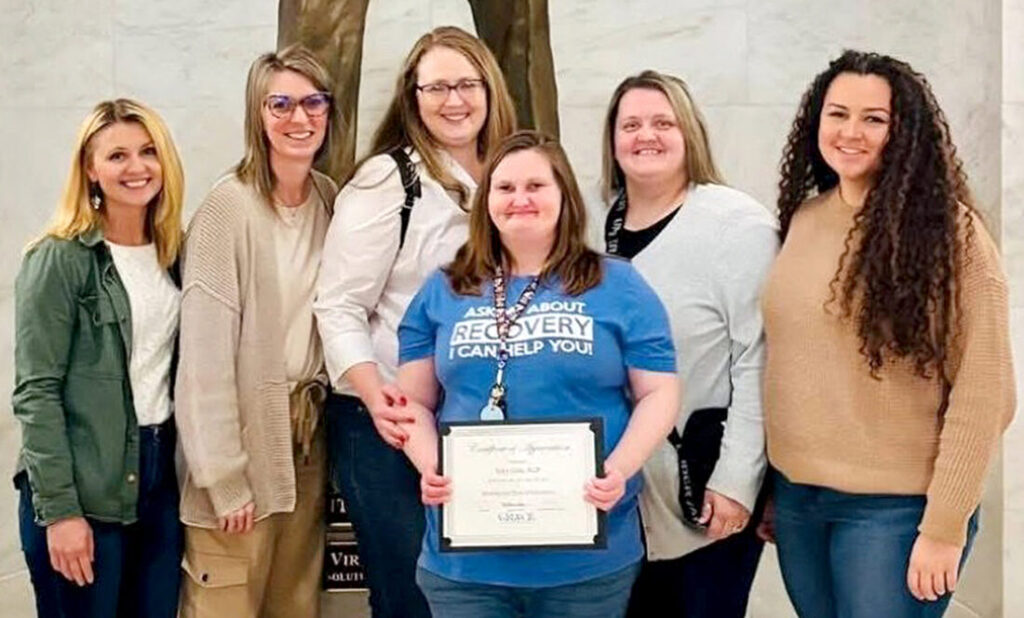Feature Article The Inter-Mountain: “Homeless in the Mountains”

About Tami Cale and Jobs & Hope WV
Tami Cale is a participant in the Jobs & Hope West Virginia program, working with Transition Agent Leah Hall in Region 6. Since joining the program in January, Tami has actively engaged with her local Adult Learning Center (ALC) and is pursuing her goal of becoming a Peer Recovery Support Specialist (PRSS). Jobs & Hope WV has supported her through monthly check-ins, referrals, and resources—including a vision voucher to help her obtain glasses and a loaner laptop to support her ongoing training. With her sights set on becoming a Substance Use Disorder (SUD) counselor, Tami’s story of resilience and progress reflects the mission of Jobs & Hope WV: helping individuals overcome barriers and build a better future.
By: Edgar Kelley, Staff Writer, The Inter-Mountain
Homeless in the Mountains
PARSONS — A local woman who has managed to climb out of homelessness told her story during Recovery Day at the West Virginia State Capitol this month, sharing her harrowing experiences in the hope of helping others.
For almost 25 years, Tami Cale struggled with her sobriety. The downward spiral for Cale, who is now 40 years old, began when she found herself homeless for the first time in her life at the age of 13. At that time she was already an alcoholic and using drugs regularly. Seventeen more years of drug addiction followed, and Cale also faced both domestic abuse and mental health issues.
Fast forward to today and Cale is a much different person. She was one of just four people to present a personal story of resilience on Recovery Day in Charleston April 10.
“To tell my story at the State Capital was extremely humbling, to say the least,” Cale, who is in her 11th month of sobriety, told The Inter-Mountain. “That was the first time I was ever asked to do anything like that. I was really shocked that I was asked to do it, because there were a lot of people they had to choose from. One piece of my recovery is to help other people and show them that there’s another path they can choose, and this was a way to do that.”
Cale said she is indebted to the Tucker Day Report, the non-profit behavioral health side of the Tucker County Community Corrections program, with pointing her in the right direction and putting her on the path of recovery.
“All of the women working with the Tucker Day Report in Tucker County have helped me in every way possible,” Cale said. “They are some of the most caring people that you could ever be around.”
Jessica James, the Tucker Day Report service coordinator and peer support specialist/life coach, said she and her fellow staff members couldn’t be prouder of what Cale has accomplished.
“We have supported Tami through Day 1 and we are very proud of where she is today,” James said. “Tami is a walking miracle and she deserves nothing more but for her story to be known. Just maybe someone that needs to hear it will be given the chance… Many people believe we (Tucker Day Report) want to arrest everybody. That’s not true and we want to break the stigma on that perspective. We are here to educate and rehabilitate.”
James joined Cale during her trip to Charleston, as did Amy Cummings ( Tucker Day Report behavioral health director), Brittany Mitchell (recovery coach professional), Alexi Baker (project coordinator) and Dominique Meadows (case manager).
Cale also credits the Harmony Ridge Recovery Center in Walker for her 11 months of sobriety.
“I am a Harmony Ridge alumni and that’s one of the things I can say I am very proud of,” Cale said. “I went through eight rehabilitation facilities before I finally got into Harmony Ridge and that’s where the difference happened.”
Cale said some of the strength she has used to beat her addictions came from when she was younger, when her mother took her two sisters and left her with no place to live.
“It was horrible when she left, but honestly it gave me the strength I needed later in my life,” she said. “I spent three years homeless back then when I was 13. When I turned 16 I had a friend take me off the streets for a little bit. Then at 17 I went to prison, and when I got out at close to 19 years old, I did quite a bit of bouncing around through multiple states.
“I would mostly sleep in abandoned buildings or behind dumpsters. Occasionally somebody would allow me to crash on their couch, or we would be at someone’s house doing some type of substance and I would pass out there.
“Unfortunately there are a lot of people out there experiencing the same thing and I hate it for them,” she said. “But they have to decide if they want to make a difference in their lives.”
Cale said there is often a direct connection between being homeless and being an addict.
“You can sustain a place to live for so long, but eventually that money is going to get in the way of getting high,” said Cale. “You will start losing things one thing at a time and then everything. Getting high becomes more important than having some place to stay, so you’re back out on the streets.
“I was faced many times with the choice of having a place to stay or going to find something else (drugs). And going to find something else was always more important.”
Cale currently has a full-time job and her own home. She has filed taxes for the first time in her life, and received her Recovery Coach Professional certification through GrAce (Greater Recovery and Community Empowerment), which was funded by Tucker Day Report.
Cale said her ultimate goal is to reunite with her daughter some day when “God sees fit.” Until then, she plans on taking another step toward helping others.
“I have another month to wait before I can get into the Peer Recovery Specialist classes and that’s my next goal,” Cale said. “That way I can use my story and my knowledge to help other people.”
